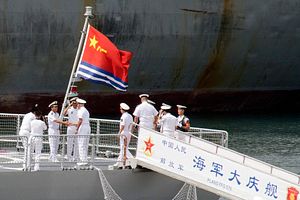During an official visit to the People’s Liberation Army Navy (PLAN) North Sea Fleet headquarters in Qingdao, China, the commander of the U.S. Pacific Fleet, Admiral Scott Swift, urged his Chinese counterparts to be more transparent about the PLAN’s intentions in the region amidst growing tensions over maritime disputes in the South China Sea, according to a U.S. Pacific Fleet readout.
Admiral Swift met with North Sea Fleet commander, Vice Admiral Yuan Yubai, on August 8 in Qingdao, located on the Yellow Sea in China’s Shandong Province. During the meeting, “Swift emphasized to Yuan the importance of transparency, parity and reciprocity in the effort to improve the relationship between the Pacific Fleet and the PLA(N),” the press release notes.
The admiral’s visit coincided with the port visit of the guided-missile destroyer USS Benfold, the first time a U.S. warship has visited a Chinese port after last month’s ruling of the Permanent Court of Arbitration on maritime disputes between China and the Philippines in the South China Sea (See: “US Navy Warship Makes 1st China Visit Since South China Sea Arbitration Ruling”).
Speaking to reporters on August 9, Swift emphasized that recent Chinese actions has had a destabilizing effect on military-to-military relations and the region in general. “I think it’s a mistake to take them individually and not look at them as a collective. And you have to look at it as an extension of an arc,” Swift told Reuters. “The uncertainty in the region is because of the lack of transparency and exactly where it is that arc is going. And that arc is defined by multiple data points,” he added.
He singled out three separate Chinese actions to support his assertion: First, the construction of hardened military aircraft hangars on Chinese-occupied artificial features in the Spratly Islands in the South China Sea. Second, Sino-Russian naval drills in the South China Sea in September. And third, the cancellation of a scheduled port visit to Hong Kong by the Nimitz-class nuclear-powered supercarrier USS John C. Stennis without explanation.
The Washington-based Center for Strategic and International Studies’ Asia Maritime Transparency Initiative revealed this week that hardened military hangars have been constructed on Fiery Cross, Subi, and Mischief reefs in the Spratly island chain. “The smallest and most numerous hangars are being built with four to six hangars per building. They can easily accommodate any fighter-jet in the People’s Liberation Army Air Force or Naval Aviation, including the J-11 and Su-30,” according to the report.
“The second type of hangar is large enough for the H-6 bomber and H-6U refueling tanker, Y-8 transport aircraft, and KJ200 Airborne Warning and Control System plane. The largest of the hangars can accommodate the largest planes in the Chinese fleet — the Y-20 and Il-76 transport planes, Il-78 refueling tanker, and KJ-2000 surveillance aircraft,” the report elaborates.“That increases the angst and uncertainty,that lack of transparency, and that is generally destabilizing as opposed to a stabilizing action,” according to Swift.
As The Diplomat reported previously, Russia and China confirmed in late July that their joint annual naval exercise, Joint-Sea 2016, will be held in the South China Sea in September. “There are other places those exercises could have been conducted,” Swift noted. ”So I think that is a matter of concern and something that should be considered from the perspective of actions that are not increasing the stability within the region,” he said.
China and Russia have conducted six joint naval exercises over the last decade. In 2015, both countries “held naval and amphibious assault exercises in the Sea of Japan, a smaller naval drill in the Mediterranean, among a number of other bilateral military exchanges. Both countries have also participated in trilateral, and multilateral exercises, for example, under the umbrella of the Shanghai Cooperation Organization (SCO),” I reported in April. China also launched a number of unilateral naval exercises in the South China Sea over the last few weeks.
In late April, the Chinese Foreign Ministry informed the U.S. Navy that it would cancel the scheduled port visit of the USS John C. Stennis without providing an explanation. The nuclear-powered aircraft carrier had been conducting patrols in the South China Sea launching hundreds of sorties while cruising the waters (See: “US Carrier Strike Group Arrives in South China Sea to Deter China”). The move was widely seen as a tit-for-tat for U.S. actions in the South China Sea including so-called freedom of navigation operations.
China has cancelled port visits in the past whenever Beijing felt undermined by U.S. diplomatic initiatives. “In 2007, the USS Reuben James and USS Kitty Hawk CSG were denied access to Chinese ports just around the time when U.S. President George W. Bush met the Dalai Lama and concluded a major arms sale with Taiwan. However, the USS Kitty Hawk was allowed to dock in Hong Kong five months later once Sino-U.S. ties normalized,” I explained.

































